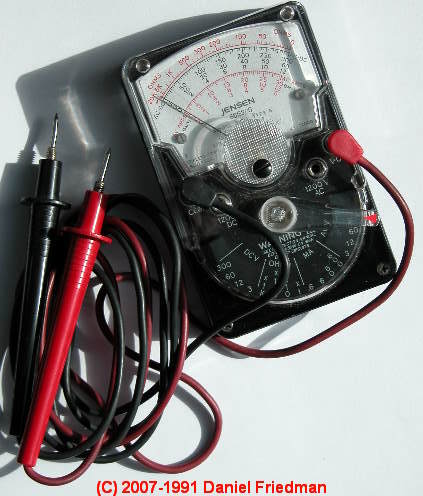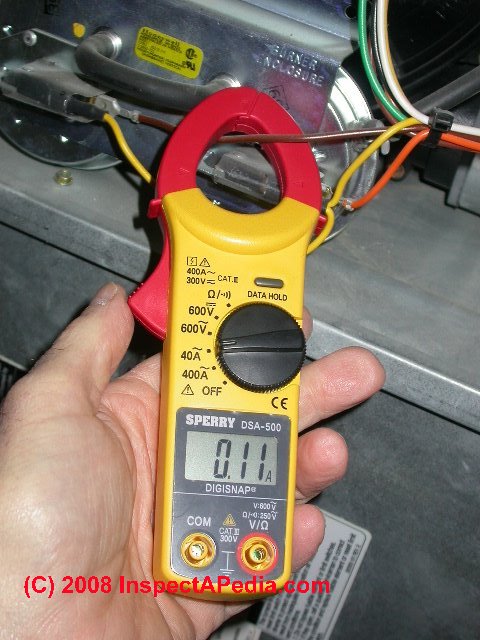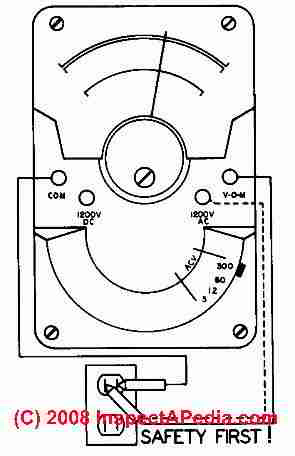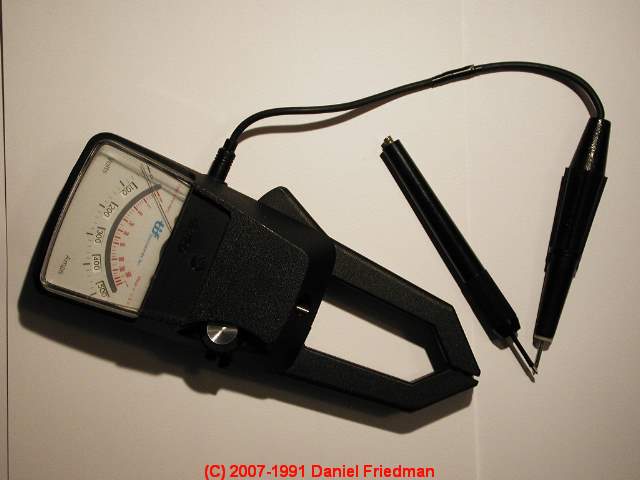 How to use Digital Multi Meters, DMMs & VOMs Safely
How to use Digital Multi Meters, DMMs & VOMs Safely
- POST a QUESTION or COMMENT about safety procedures when using a DMM or digital multimeter
DMM - digital multimeter safety:
This article discusses safety procedures to follow when using digital multi meters or DMMs or VOMs.
We describe safety procedures for inspecting residential electric panels and building wiring using DMMs, volt meters, VOMs, and similar electrical test equipment.
These DMM/VOM safety procedures aid in addressing safety hazards found at residential electrical panels and electrical wiring systems and are intended for the electrical inspector, home inspector, or other professionals who examine residential electrical systems.
Safe electrical inspection procedures and safe use of volt meters, DMMs, multimeters, and similar electrical test equipment are discussed. Original text: DF, as ASHI Technical Journal Staff, January 1992, with updates through 2012.
InspectAPedia tolerates no conflicts of interest. We have no relationship with advertisers, products, or services discussed at this website.
- Daniel Friedman, Publisher/Editor/Author - See WHO ARE WE?
Safe Use of Electrical Test Equipment: DMMs & VOMs
 In some circumstances, when examining electrical panels, receptacles, or other electrical devices in a building, ASHI, CREIA, CAHI, or other home inspectors may elect to make
current and voltage measurements.
In some circumstances, when examining electrical panels, receptacles, or other electrical devices in a building, ASHI, CREIA, CAHI, or other home inspectors may elect to make
current and voltage measurements.
For inspectors who elect to use these tools, make sure that the tools themselves do not become a source of damage, or injury.
The following tips are based on a short article by Leonard Ogden in CEE News.
Shown here is my little Jensen analog VOM (volt ohm meter) which has served flawlessly for decades. At the top of this page is our still smaller pocket digital DMM DM78 made by CircuitMate™.
Other examples of VOMs and ammeters or current measuring instruments are shown below.
How to Test digital volt meter DMM or Volt Ohm Meter VOM meter condition
High energy measurement instruments:
Use only DMM's (digital multi meters) or VOMs (volt-ohm meters, the analog predecessors to DMMs) designed for high energy measurements.
Frequently check for damage to the meter itself,
or for loose, cut, or worn test leads. If you can see the conductor in the leads, replace them. Check that there is low resistance between the leads themselves - a partial indication of good condition.
Use well insulated test leads
that have finger guards.

Insulate yourself
from possibly live electrical parts by careful selection of clothing, leather boots, and where appropriate, insulated gloves.
Wear gloves:
If you cannot operate your equipment while wearing gloves you have a safety problem. (Photo at left).
Use the proper voltage range
and other control settings on the meter.
If you attempt a voltage measurements with test leads in the amps or current jack (
a big but common mistake) and if your probes or meter are not fused, the resulting short across the voltage source can cause an explosion in the meter.
The photo (left) shows our Sperry Digisnap™ DSA-500 clamp-on ammeter that also functions as a digital VOM multimeter and continuity tester. Here, missing safety gloves, the DMM user was measuring 0.11 Amps current draw at a control on a gas-fired warm air furnace.
The openings at the bottom of the meter show that before attempting a current (amps) measurement the user removed the test leads from the instrument.
Don't use a DMM or VOM meter having cracked or loose parts. I
n selecting a meter, look for recessed input jacks to reduce shock risks at the connectors.
A simple volt ohm meter
(VOM) such as the TriplettTM 310 shown here can be used to test for unexpected and unsafe voltage at a component. Set the VOM in the highest AC-voltage range.
 One probe of the VOM is used to contact the surface of the electric panel
One probe of the VOM is used to contact the surface of the electric panel
(or any component to be examined), the other probe is touched to a reliable ground source,
[NOTE: Once having tested at the highest voltage range, greater accuracy may be obtained by choosing more sensitive ranges which permit readings to be taken in the upper portion of the scale.
Disconnect the test probes
(or shut off the voltage source) before changing the voltage range setting on the VOM.] or in the example shown, to the neutral side of the circuit.
For example, if the VOM meter indicates more than 1or 2 volts between a service panel cover and ground, there's a safety problem.
Most low-cost analog-type meters such as the one described provide additional ranges used to read lower voltages with more sensitivity.
Some VOM models provide alligator clips for the ends of the test probes.
These clips permit measuring high voltage without handling the probes.
Always shut off the power before connecting the alligator clips.
This clamp-on multimeter (shown below) made by TriplettTM can measure amperage draw (I (DF) used it when servicing and testing air conditioning system compressors) but it also includes probes permitting the device to be used as a standard, if slightly awkward probing VOM as well.
One feature we liked on this analog meter was the adjustable scale which permits measuring voltages in ranges of 1-5 volts, 5-25 volts, 25 to 125 volts, 100 60 500 volts (our scale for inspecting residential electrical equipment), high voltages from 250V up to 1250 volts, and as well, an ohms scale - making this a versatile analog multimeter.
After nearly 20 years we still make occasional use of this nice analog meter. Here's close up of the adjustable scale On this meter.
Electrical Inspection techniques Using DMMs and VOMs

Amp measurements
using voltage clamps avoid extra risks of having to handle live wires. [See sketch at above left.]
To measure amps or current
Also see DMM DIGITAL MULTIMETER HOW TO USE
for the proper DMM or VOM function and range settings.
When measuring amps without a current clamp, m
ake sure power is off before connecting into the circuit.
When disconnecting the multimeter or voltmeter,
always unplug the red (hot) lead first.
Also see SAFETY for ELECTRICAL INSPECTORS
Safe Use of Electrical Test Equipment: DMMs & VOMs
8.3 During an electrical system inspection the inspector is NOT required to
8.3.A. insert any tool, probe, or testing device inside the panels [Excerpt from ASHI Standards for home inspectors - Ed]
Do Not Grab an Shake SEC Entry Mains in the Panel
In his final electrical seminar in St. Louis a decade ago, Bob Smith, a lecturer from SHRC, the Small Homes Research Council, told ASHI home inspectors and candidates that he always verifies the quality of the service connection at the main breaker by grabbing the two hot entrance wires and giving them and the panel a good shake.
Watch out: Don't do this! Readers would not be warned here if this questionable advice had not been presented at that seminar. Electricians and trained experts work with live electrical wires. Home inspectors should not do so.
October 22, 1988 - El Cajon, CA - a young electrician died when he accidentally electrocuted himself. Acting police Lt. Carl Case said 19-year-old Sean M. Smith was working under a house, lying on his back working on an electrical addition to the house, when his wire [strippers] accidentally connected with a live wire.
He said Smith's boss, Troy Beatty, heard the victim yell. Beatty found Smith unconscious under the house, pulled him out, performed CPR, and summoned help. -- IAEI News, November/December 1990 p.40.
These electrical inspection suggestions are not a complete inventory of all electrical components that should be inspected; these notes focus on identification of conditions that may present special electrical hazards for the electrical inspector.
Contact Us by email to suggest changes, corrections, and additions to this material.
ELECTRICAL INSPECTOR SAFETY PROCEDURES describes important basic safety procedures, clothing, gloves, eye protection, and other safety equipment for home inspectors and electrical inspectors.
Safety Warnings for Electrical Inspectors & Home Inspectors Using Electrical Test Equipment on Building Electrical Systems & Devices
Watch Out: The ASHI Standards of Practice and other home inspection standards for electrical inspections do not require the inspector to insert any instrument into the service panel.
Therefore this testing is optional. It's also a dangerous procedure that can damage electrical equipment or worse, cause electrical shock, or even death, and should not be undertaken unless the person conducting the examination is trained and competent to avoid electric shock. If the inspector is not trained for this procedure s/he should never insert any instrument or tool into electrical equipment.
See SAFETY for ELECTRICAL INSPECTORS at Residential Electric Panels.
Simpson Instruments adds the following safety advice for users of VOMs and DMMs and similar test devices, and other instrument manufacturers offer similar cautions: [6]
- The test instrument should only be used by personnel qualified to recognize shock hazards and trained in the safety precautions required to avoid possible injury.
- Do not work alone when measuring circuits where a shock hazard might exist. Notify a nearby person that you are making, or intend to make such measurements.
- Locate all voltage sources and accessible current paths before making measurement
connections.
Be sure that the equipment is properly grounded and the right rating and type of fuse(s) is installed. Set the Instrument to the proper range before applying power.
Voltage might appear unexpectedly in defective equipment. An open bleeder resistor can result in a capacitor retaining a dangerous charge. Turn the power off and discharge all capacitors before connecting or disconnecting the Instrument. - Inspect the test leads for cracks, breaks or crazes in the insulation, probes and connectors before each use. If any defects are noted, replace the test leads immediately.
- Do not measure in a circuit where corona is present. Corona can be identified
by a pale blue color emanating from sharp metal points in the circuit, or
by a buzzing sound, or by the odor of ozone. In rare instances, such as
around germicidal lamps, ozone might be generated as a normal function.
Ordinarily, the presence of ozone indicates the presence of high voltage and probably an electrical malfunction. - Hands, shoes, floor and workbench must be dry. Avoid making measurements under humid, damp or other environmental conditions that could affect the dielectric withstanding voltage of the test leads or the Instrument.
- For maximum safety, do not touch test leads or Instrument while power is applied to the circuit under test.
- Use extreme caution when making measurements where a dangerous combination of voltages could be present, such as in an RF amplifier.
- Do not make measurements using test leads of lesser safety than those originally furnished with the Instrument.
- Do not touch any object which could provide a current path to the common side of the circuit under test or power line ground. Always stand on a dry insulated surface capable of withstanding the voltage being measured.
- Do not connect to an electrically energized circuit in a hazardous area.
- No General Purpose VOM is to be used to make electrical measurements on blasting circuits or blasting caps.
Fluke adds this safety advice: To avoid possible electric shock or personal injury, follow these guidelines: [5]
- Use this Meter only as specified in this manual or the protection provided by the Meter might be impaired.
- Do not use the Meter if it is damaged. Before you use the Meter, inspect the case. Look for cracks or missing plastic. Pay particular attention to the insulation surrounding the connectors.
- Make sure the battery door is closed and latched before operating the Meter.
- Make sure the battery door is closed and latched before operating the Meter.
- Remove test leads from the Meter before opening the battery door. • Inspect the test leads for damaged insulation or exposed metal. Check the test leads for continuity. Replace damaged test leads before you use the Meter.
- Do not apply more than the rated voltage, as marked on the Meter, between the terminals or between any terminal and earth ground.
- Never operate the Meter with the cover removed or the case open.
- Use caution when working with voltages above 30 V ac rms, 42 V ac peak, or 60 V dc. These voltages pose a shock hazard. • Use only the replacement fuses specified by the manual.
- Use the proper terminals, function, and range for measurements.
- Avoid working alone.
- When measuring current, turn off circuit power before connecting the Meter in the circuit. Remember to place the Meter in series with the circuit.
- When making electrical connections, connect the common test lead before connecting the live test lead; when disconnecting, disconnect the live test lead before disconnecting the common test lead.
- Do not use the Meter if it operates abnormally. Protection may be impaired. When in doubt, have the Meter serviced. • Do not operate the Meter around explosive gas, vapor, or dust.
- Use only 1.5 V AA batteries, properly installed in the Meter case, to power the Meter.
- When servicing the Meter, use only specified replacement parts.
- When using probes, keep fingers behind the finger guards on the probes.
- Do not use the Low Pass Filter option to verify the presence of hazardous voltages. Voltages greater than what is indicated may be present. First, make a voltage measurement without the filter to detect the possible presence of hazardous voltage. Then select the filter function.
- Only use test leads that have the same voltage, category, and amperage ratings as the meter and that have been approved by a safety agency.
- Use proper protective equipment, as required by local or national authorities when working in hazardous areas.
- Comply with local and national safety requirements when working in hazardous locations.
Additional Advice to Avoid Damaging VOM or DMM & Equipment
Fluke adds this advice: To avoid possible damage to the Meter or to the equipment under test, follow these guidelines: [5]
- Disconnect circuit power and discharge all high-voltage capacitors before testing resistance, continuity, diodes, or capacitance.
- Use the proper terminals, function [be sure the function switch is set to the proper position] , and range for all measurements.
- Do not remove batteries while the Meter is turned on or a signal is applied to the Meter’s input jacks.
- Before measuring current, check the Meter's fuses. (See "Testing the Fuses" in the Users Manual on the accompanying CD.)
- Do not use the LoZ mode to measure voltages in circuits that could be damaged by this mode’s low impedance (≈3 kΩ). (Model 289 only)
...
Reader Comments, Questions & Answers About The Article Above
Below you will find questions and answers previously posted on this page at its page bottom reader comment box.
Reader Q&A - also see RECOMMENDED ARTICLES & FAQs
How can I check those wires to make sure there are no shorts?
I want to use the existing wires to put in a new well pump. How can I check those wires to make sure there are no shorts? On 2017-07-16 by J.J. Holloway
by (mod) -
JJ:
With the wires disconnect at BOTH ends - no live power nearby as you could be killed - you'd then tie the two wire ends together at one end and at the other end use your VOM or DMM to test for continuity and resistance. Resistance should be about zero.
Review our article on USING A DMM or VOM SAFELY (you are on this page)
or also see ELECTRICAL TOOLS BASIC
This is not an absolutely technically exhaustive test but it's a reasonable and easy one.
What this won't find is nicked insulation or damaged wire that's not shorted together (wire to wire) but that might leak current to the earth when power is applied and particularly when the soil is wet. You or a more-trained electrician can make further tests of leakage to earth out of each wire lead after a period of wet weather.
FYI if a circuit is protected by a GFCI circuit breaker and there is a current leak to ground or hot to neutral the GFCI should trip - which can also be used as an amateur diagnostic tool.With that method we found circuits in my brother-in-law's DIY apartment wiring job that had been shorted by over-tightening the wire clamps at metal boxes in NYC.
Why is my pump circuit breaker tripping?
My control box is approx. 275' from power supply. it has worked for years with with 8-2 w/g in-ground wire in pvc elec.pipe.
The breaker started tripping,i changed the control box,pressure switch and breaker switch. nothing helped so i called the well people that i have used before he stated there was a break somewhere in the 250' line and charged me $150.00.
I dug until i found the break,repaired the break and checked everything but the breaker kept tripping. i wanted to know if i could place a breaker at the end of the line where i made the repair to see if the wire was good to there from my breaker in my breaker box. Thank You On 2017-05-31 by fred mullins -
by (mod) -
Fred,
I think what's best would be to use a DMM or VOM with POWER DISCONNECTED completely from the pump circuit - then check the resistance of the wires for continuity or for a short between them.
Sure you could use a breaker as a temporary safety device in the middle of a circuit but placing breaker and wiring there instead of checking the actual wires sounds dangerous to me.
...
Continue reading at DMM DIGITAL MULTIMETER HOW TO USE or select a topic from the closely-related articles below, or see the complete ARTICLE INDEX.
Or see these
Recommended Articles
- ANALOG VOMs & MULTIMETERS
- BASIC ELECTRICAL TESTS for BURNED OUT COMPRESSOR MOTORS
- ELECTRIC MOTOR DIAGNOSTIC GUIDE - home
- SAFETY for ELECTRICAL INSPECTORS
Suggested citation for this web page
DMMs VOMs SAFE USE OF at InspectApedia.com - online encyclopedia of building & environmental inspection, testing, diagnosis, repair, & problem prevention advice.
Or see this
INDEX to RELATED ARTICLES: ARTICLE INDEX to ELECTRICAL INSPECTION & TESTING
Or use the SEARCH BOX found below to Ask a Question or Search InspectApedia
Ask a Question or Search InspectApedia
Try the search box just below, or if you prefer, post a question or comment in the Comments box below and we will respond promptly.
Search the InspectApedia website
Note: appearance of your Comment below may be delayed: if your comment contains an image, photograph, web link, or text that looks to the software as if it might be a web link, your posting will appear after it has been approved by a moderator. Apologies for the delay.
Only one image can be added per comment but you can post as many comments, and therefore images, as you like.
You will not receive a notification when a response to your question has been posted.
Please bookmark this page to make it easy for you to check back for our response.
IF above you see "Comment Form is loading comments..." then COMMENT BOX - countable.ca / bawkbox.com IS NOT WORKING.
In any case you are welcome to send an email directly to us at InspectApedia.com at editor@inspectApedia.com
We'll reply to you directly. Please help us help you by noting, in your email, the URL of the InspectApedia page where you wanted to comment.
Citations & References
In addition to any citations in the article above, a full list is available on request.
- Electrical shock injury statistics: www.healthatoz.com - September 2008;
- Daniel Friedman - Publisher & Editor of InspectAPedia.com®
- N. Srinivasan, MSEE, is a senior member of IEEE with 30 years experience in the electrical industry. Mr. Srinivasan is in Vienna VA.
- Louis P. Babin generously contributed technical editing about the effects of doubling ampacity in an electrical circuit (September 2007)
- ASHI Technical Journal, Vol. 2. No. 1, January 1992, "Determining Service Ampacity," Dan Friedman and Alan Carson, and the
- ASHI Technical Journal, Vol. 3. No. 1, Spring, 1993, "Determining Service Ampacity - Another Consideration," Robert L. Klewitz, P.E., with subsequent updates and additions to the original text ongoing to 2/19/2006. Reprints of the originals and reprints of the Journal are available from ASHI, the American Society of Home Inspectors www.ashi.com.
- [4] Digisnap DSA-500 snap-around digital multimeter, A.W. Sperry Instruments Inc., 2150 Joshua's Path, Suite 202, Hauppage NY 11788, Tel: 800-645-5398, Email: cat@awsperry.com, Website: www.awsperry.com
- [5] Fluke Corporation, 6920 Seaway Blvd, Everett, WA 98203, USA, PO Box 9090 Everett, Washington 98206, Tel: +1(425) 347-6100, Technical support: 1(800) 44-FLUKE (1(800) 443-5853), Website: www.fluke.com,
Fluke Europe B.V, PO Box 1186 Eindhoven, The Netherlands, Tel: +31 (0)40 2 675 200 +31 (0)40 2 675 222, Website: www.fluke.eu- Digital 287/289 Digital Multimeter, Users Manual, retrieved 9/5/21, original source: http://assets.fluke.com/manuals/287_289_umeng0200.pdf, [copy on file as Fluke_287_289_umeng0200.pdf]
- [6] Simpson Electric, P.O. Box 99, 520 Simpson Avenue, Lac du Flambeau, WI 54538-0099 Tel: 715-588-3311, customer service: 715-588-3947, Email: support@simpsonelectric.com, Website: www.simpsonelectric.com/
- Simpson 260® Series 6XLM Volt-Ohm-Milliammeter Instruction Manual, retrieved 9/5/2012, original source: http://www.simpsonelectric.com/uploads/File/datasheets/260-6xlm.pdf, [copy on file as Simpson_260-6xlm.pdf]
- [7] tif 300cc Tic Tracer voltage detector, Tif Instruments Inc., 9101 NW 7th Avenue, Miami, Florida 33150
- [8] Greenlee® GT-16 adjustable voltage detector, Greenlee Textron Inc., Website: greenlee.com, Tel: 800-435-0786 , Email: echsupport@greenlee.textron.com,
- "Electrical System Inspection Basics," Richard C. Wolcott, ASHI 8th Annual Education Conference, Boston 1985.
- "Simplified Electrical Wiring," Sears, Roebuck and Co., 15705 (F5428) Rev. 4-77 1977 [Lots of sketches of older-type service panels.]
- "How to plan and install electric wiring for homes, farms, garages, shops," Montgomery Ward Co., 83-850.
- "Simplified Electrical Wiring," Sears, Roebuck and Co., 15705 (F5428) Rev. 4-77 1977 [Lots of sketches of older-type service panels.]
- "Home Wiring Inspection," Roswell W. Ard, Rodale's New Shelter, July/August, 1985 p. 35-40.
- "Evaluating Wiring in Older Minnesota Homes," Agricultural Extension Service, University of Minnesota, St. Paul, Minnesota 55108.
- "Electrical Systems," A Training Manual for Home Inspectors, Alfred L. Alk, American Society of Home Inspectors (ASHI), 1987, available from ASHI. [DF NOTE: I do NOT recommend this obsolete publication, though it was cited in the original Journal article as it contains unsafe inaccuracies]
- "Basic Housing Inspection," US DHEW, S352.75 U48, p.144, out of print, but is available in most state libraries.
- In addition to citations & references found in this article, see the research citations given at the end of the related articles found at our suggested
CONTINUE READING or RECOMMENDED ARTICLES.
- Carson, Dunlop & Associates Ltd., 120 Carlton Street Suite 407, Toronto ON M5A 4K2. Tel: (416) 964-9415 1-800-268-7070 Email: info@carsondunlop.com. Alan Carson is a past president of ASHI, the American Society of Home Inspectors.
Thanks to Alan Carson and Bob Dunlop, for permission for InspectAPedia to use text excerpts from The HOME REFERENCE BOOK - the Encyclopedia of Homes and to use illustrations from The ILLUSTRATED HOME .
Carson Dunlop Associates provides extensive home inspection education and report writing material. In gratitude we provide links to tsome Carson Dunlop Associates products and services.


